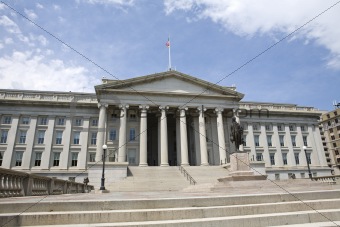The REAL Battle Over America’s Banking System
Courtesy of Washington’s Blog
 New York Versus the Rest of the Country
New York Versus the Rest of the Country
If you are happy with the banking system, and don’t think it needs to be reformed, then you probably work for one of the banks headquartered in New York.
Indeed, the banks outside of New York have acted much more conservatively, used more conservative capital ratios and less leverage and gotten less involved in credit derivatives and other speculative investments.
Buy a banker in the Midwest a drink, and he will probably rail against the giant New York banks for causing the financial crisis, costing the smaller, better run banks a lot of money and huge fees, and driving many smaller banks out of business.
And even within the Federal Reserve, what the New York Fed and Bernanke are saying is wholly different from what the heads of the regional Fed banks are saying. The Fed banks in Philadelphia and Kansas City and Dallas and elsewhere disagree with what the New York Fed and Fed’s Open Market Committee are doing. See this and this.
So the battle isn’t between bankers versus outsiders. It is between the giant New York money-centered banks and the rest of the country.
Reserve Requirements
Congresswoman Kaptur said last week:
We used to have capital ratios. We need to get back to them. Ten to one. For every dollar in your bank, you can lend ten. You know what J.P. Morgan did? A hundred to one. And then with derivatives, who knows how much?
Remember, Milton Friedman – the monetary economist worshipped as the guy with all of the answers in the latter part of the 20th century – advocated for 100% reserves.
Forget 100 to 1 or even 10 to 1. Friedman said the capital ratio should be 1 to 1, where banks only lend out the amount they actually have as deposits on hand.
Friedman has been deified as the economist to follow. But his views on reserve requirements have been completely ignored.
Congresswoman Kaptur also said last week:
Banks have the power to create money. And decide how much that is worth.
What is Kaptur talking about?
Here Comes the Judge
Well, in First National Bank v. Daly (often referred to as the "Credit River" case) the court found: that the bank created money "out of thin air":
[The president of the First National Bank of Montgomery] admitted that all of the money or credit which was used as a consideration [for the mortgage loan given to the defendant] was created upon their books, that this was standard banking practice exercised by their bank in combination with the Federal Reserve Bank of Minneaopolis, another private bank, further that he knew of no United States statute or law that gave the Plaintiff [bank] the authority to do this.
The court also held:
The money and credit first came into existence when they [the bank] created it.
(Here’s the case file).
Still confused?
Nobel Economists, Congressmen, the Fed and Treasury Agree
Well, let’s hear from some top economists.
As PhD economist Steve Keen pointed out recently, 2 Nobel-prize winning economists have shown that the assumption that reserves are created from excess deposits is not true:
The model of money creation that Obama’s economic advisers have sold him was shown to be empirically false over three decades ago.
The first economist to establish this was the American Post Keynesian economist Basil Moore, but similar results were found by two of the staunchest neoclassical economists, Nobel Prize winners Kydland and Prescott in a 1990 paper Real Facts and a Monetary Myth.
Looking at the timing of economic variables, they found that credit money was created about 4 periods before government money. However, the “money multiplier” model argues that government money is created first to bolster bank reserves, and then credit money is created afterwards by the process of banks lending out their increased reserves.
Kydland and Prescott observed at the end of their paper that:
Introducing money and credit into growth theory in a way that accounts for the cyclical behavior of monetary as well as real aggregates is an important open problem in economics.
In other words, if the conventional view that excess reserves (stemming either from customer deposits or government infusions of money) lead to increased lending were correct, then Kydland and Prescott would have found that credit is extended by the banks (i.e. loaned out to customers) after the banks received infusions of money from the government. Instead, they found that the extension of credit preceded the receipt of government monies.
Keen explained in an interview Friday that 25 years of research shows that creation of debt by banks precedes creation of government money, and that debt money is created first and precedes creation of credit money.
As Mish has previously noted:
Conventional wisdom regarding the money multiplier is wrong. Australian economist Steve Keen notes that in a debt based society, expansion of credit comes first and reserves come later.
This angle of the banking system has actually been discussed for many years by leading experts:
“[Banks] do not really pay out loans from the money they receive as deposits. If they did this, no additional money would be created. What they do when they make loans is to accept promissory notes in exchange for credits to the borrowers’ transaction accounts."
– 1960s Chicago Federal Reserve Bank booklet entitled “Modern Money Mechanics”“The process by which banks create money is so simple that the mind is repelled.”
– Economist John Kenneth Galbraith[W]hen a bank makes a loan, it simply adds to the borrower’s deposit account in the bank by the amount of the loan. The money is not taken from anyone else’s deposit; it was not previously paid in to the bank by anyone. It’s new money, created by the bank for the use of the borrower.
– Robert B. Anderson, Secretary of the Treasury under Eisenhower, in an interview reported in the August 31, 1959 issue of U.S. News and World Report“Do private banks issue money today? Yes. Although banks no longer have the right to issue bank notes, they can create money in the form of bank deposits when they lend money to businesses, or buy securities. . . . The important thing to remember is that when banks lend money they don’t necessarily take it from anyone else to lend. Thus they ‘create’ it.”
-Congressman Wright Patman, Money Facts (House Committee on Banking and Currency, 1964)"The modern banking system manufactures money out of nothing. The process is perhaps the most astounding piece of sleight of hand that was ever invented.
– Sir Josiah Stamp, president of the Bank of England and the second richest man in Britain in the 1920s.Banks create money. That is what they are for. . . . The manufacturing process to make money consists of making an entry in a book. That is all. . . . Each and every time a Bank makes a loan . . . new Bank credit is created — brand new money.
– Graham Towers, Governor of the Bank of Canada from 1935 to 1955
Monetary reformers argue that the government should take the power of money creation back from the private banks and the Federal Reserve system.
 Indeed, PhD economist and candidate for Florida governor Farid Khavari wants to create a Bank of the State of Florida, to create credit without burdening the state and its citizens with high interest charges by private banks.
Indeed, PhD economist and candidate for Florida governor Farid Khavari wants to create a Bank of the State of Florida, to create credit without burdening the state and its citizens with high interest charges by private banks.
The state of North Dakota already has such a bank.
The bottom line is that monetary reformers argue that letting banks create credit and money and then charge high interest rates creates massive levels of debt for states and taxpayers. They argue that the power to create money should be reclaimed by the government and taken away from the private banks.
Personally, I agree with the monetary reformers. But even for those who think this is too radical a proposition, the question is whether a system where debt has to constantly and continually expand to keep the economy afloat is sustainable.
The Ever-Expanding Bubble
 In a hearing held on September 30, 1941 in the House Committee on Banking and Currency, then-Chairman of the Federal Reserve (Mariner S. Eccles) said:
In a hearing held on September 30, 1941 in the House Committee on Banking and Currency, then-Chairman of the Federal Reserve (Mariner S. Eccles) said:
That is what our money system is. If there were no debts in our money system, there wouldn’t be any money.
Indeed, Robert H. Hemphill, Credit Manager of the Federal Reserve Bank of Atlanta, said:
If all the bank loans were paid, no one could have a bank deposit, and there would not be a dollar of coin or currency in circulation. This is a staggering thought. We are completely dependent on the commercial Banks. Someone has to borrow every dollar we have in circulation, cash or credit. If the Banks create ample synthetic money we are prosperous; if not, we starve. We are absolutely without a permanent money system. When one gets a complete grasp of the picture, the tragic absurdity of our hopeless position is almost incredible, but there it is. It is the most important subject intelligent persons can investigate and reflect upon. It is so important that our present civilization may collapse unless it becomes widely understood and the defects remedied very soon.
It should be obvious to everyone that America’s banking system needs to be reformed.
All images courtesy of Crestock. To view more images, visit their site by clicking here.



